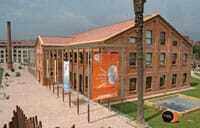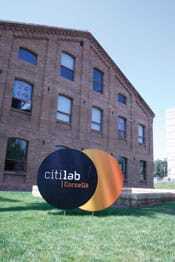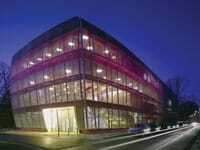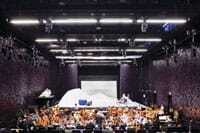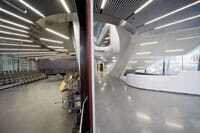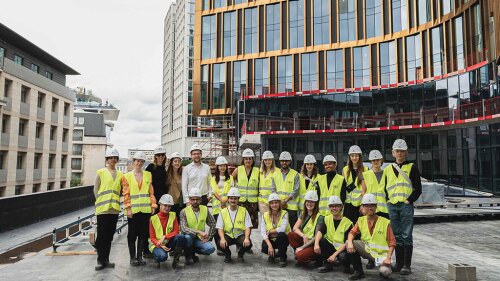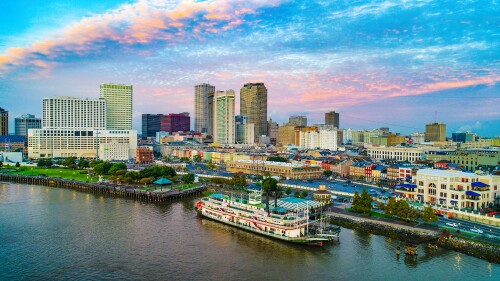Four projects take honors in the ULI Awards for Excellence: EMEA competition.
The winners of this year’s ULI Awards for Excellence: Europe, Middle East, and Africa (EMEA) competition share a common element: each is an innovative example of land use that significantly enriches its environment. Yet, it is the contribution of a host of factors that combines to entitle them to the prize, widely recognized as ranking among the land use industry’s most prestigious.The winners of the award, announced June 28 at ULI Europe’s Trends Conference in London, are New District Miasteczko Wilanów (MW) in Warsaw, Poland; Citilab in Cornella de Llobregat, Spain; Palazzo Tornabuoni in Florence, Italy; and the Mumuth Music Theatre in Graz, Austria. They were selected from among 43 entries from 17 countries by a group of renowned land use development and design experts.
The large number of applications and the high quality of the projects demonstrates that well-designed, well-built projects can thrive even in difficult economic times, said jury chairman Ian Hawksworth, managing director of London-based Capital & Counties. “These are great examples of success that showcase creativity, innovation, and long-term thinking,” he said upon whittling down the field to 14 finalists. “Perhaps now more than ever, the ULI Awards for Excellence program reminds us of the key difference that responsible land use development can make in terms of longevity and overall community sustainability.”
MW, the largest of the winning projects, is a good example of this. This long-term project aims to provide enduring value, a concept forfeited by Warsaw during the past century. Shattered by two wars during the 20th century, over the past two decades the city has been dominated by an opportunistic, short-term, and incoherent approach to development. Though a private sector–led venture, MW has attempted to reestablish sustainable planning and development practices.
Developer Prokom Investments and development consultant IN-VI Investment Environments are on target to deliver an ambitious 418-acre (169-ha) socially inclusive and architecturally rich mixed-use, pedestrian-orientated district by 2016. The project, half completed, is currently home to more than 20,000 people from different generations and backgrounds and already feels like a self-sufficient neighborhood. The judges were particularly impressed by the scale of the project, as well as the fact that it is led by a range of commercial and community groups.
An unusual element of the project is that many of the principles that shaped its master plan are contrary to current standard market practices in the region, which include single-use districts, gated residential enclaves, interior shopping malls, and priority given to automobile connections and parking.
The development is based not only on what people in a nascent capitalist economy desire—shopping malls, office buildings, entertainment facilities, single-family homes, available parking—but also what they need in order to achieve greater fulfillment, such as places of worship and education, health care centers, and protected natural areas.
MW is heavily profit driven: it is proving successful for investors with both short-term and high-return objectives. Any development parcel at the site had to be directly profitable or create a significant residual value, a notion that attracted investors from nine countries, as well as Poland.
Citilab, near Barcelona, is another example of innovation that has helped revitalize a desolate area and represents a new era of business. Completed in July 2007 by developer Fundació per la promoció de la societat del coneixement, the project redeveloped an abandoned textile factory in a former industrial area as part of a conservation project driven by the local government. The 54,000-squarefoot (5,000-sq-m) project, which was delivered within budget and not intended for economic gain, now operates as a center for social and digital innovation that includes a training and research unit, as well as an incubator for business and social initiatives.
“Revitalizing this 110-year-old structure has been innovatively executed,” the jury reported. “The developers have worked within the limitations of the main walls and floors, and the use has been well fitted into the spaces.” Architecturally, the project has adapted a historic site for a modern, nonpolluting use, resulting in the upgrade of a depressed urban area.
Citilab is situated at the heart of a neighborhood that is undergoing major urban renewal, with about 10,700 square feet (1,000 sq m) of the area leased to local startup companies, and an equal amount of space devoted to local entrepreneurs and community associations. The project has helped the local community—from youths to budding entrepreneurs—embrace technology by providing the technological and physical environment to allow growth. It seeks to reach out to both young and older generations equally.
The judges were struck by the project’s combination of a creative business model within restoration of the historic building. Furthermore, the project is economically sustainable and is thriving without government subsidy. “It is creative in the way it works with challenges, and in producing a project that carries history into the future. Such projects set an example for other such important landmarks; restoration projects with such an important social impact like this one should be encouraged,” the jury concluded.
In Florence, the meticulous restoration of Palazzo Tornabuoni—the 15th-century palace owned by the Medici during the Renaissance and occupied by Pope Leo XI—has elevated the entire area of the city and has enhanced Florence’s retail offerings. In the project, Kitebrook Partners and R.D.M. Real Estate Development have converted a former bank headquarters into a 183,000-square-foot (17,000-sq-m) mixed-use city block featuring luxury retailers, office space, restaurants, and Italy’s first private residence club, managed by Four Seasons Hotels & Resorts— maintaining strong links to the urban fabric of Florence while offering several new features and amenities.
Sympathetic to its surroundings, the building has been delicately renovated and restored to its original glory and exists within what has become one of the premier locations in Florence. The street level has been fully rented to brand-name retailers, including Cartier, Bulgari, and Max Mara, with the rents covering the cost of debt for the whole project, making it a financial success. Sales of the residence club are reported to be progressing as planned.
Palazzo Tornabuoni is part of a broader effort by Florence, its residents, and cultural and educational institutions to move away from one-time/quick-stop/low-quality tourism toward come-again/stay-a-while/high-quality tourism.
In praising the architecture and design of the building, the jury described the project as “a historic restoration of exceptional quality to create a masterpiece in the center of Florence.” By attracting visitors to the city, it contributes to the community and, given the increasing importance of restoring existing building stock, the judges saw this as a prime example of what others could aspire to.
Also honored for its aesthetic and cultural distinctions, Mumuth Music Theatre is a pioneer in terms of its design, which is based on a series of contrasts that work in harmony. Part of a University of Music and Performing Arts facility intended for use by students and visitors, the building is multifunctional, incorporating different programs and logistics in one building. For example, custom-designed acoustic panels are adjustable to meet the sound requirements of varying performance types.
The project’s innovative “blob to box” model, designed by architects UNStudio, enables integration of the modern building with classical music and its neoclassical surroundings. The internal space is divided into two parts—the blob, which gives shape to the public spaces, and the box, which covers all other areas—and conveys two different typologies within one structure. The building, which combines an 1840s classic palace in the middle of a green park with the modern and radically designed Mumuth theater, also features a high-tech acoustic laboratory and restaurant areas.
“The exceptional design and execution of-this project are hugely impressive,” the jurysaid. “It brings together futuristic design for highly specific functions with the restoration of a classical palace.”
Developed by state-owned BIG Bundesimmobiliengesellschaft and opened in March 2009, the 67,000-square-foot (6,200-sq-m) project uses cutting-edge materials such as high-performance concrete. Its design reflects the building’s use: given that it is open only to students during the day but open to the public for regular music or theatrical performances in the evening, the facade is covered by a mesh net that makes it appear opaque in daylight but transparent at night with internal lighting.
The other finalists for the ULI Awards for Excellence: EMEA competition were:
- Beursplein, a multiuse urban development in Rotterdam, by Multi Vastgoed;
- Cabot Circus, a retail-led mixed-used project in Bristol, U.K., by a joint venture between Land Securities and Hammerson;
- Dickens Heath Village Centre, a mixed-use development in Solihull, U.K., by Parkridge Holdings;
- Ener[Gie]nger, a retail showroom in Munich, by Wilhelm Gienger Verwaltungs;
- Eos Generali, an office building in Paris, by Bouygues Immobilier;
- Istinye Park, a shopping center in Istanbul, by Orta Gayrimenkul Yatirim Yonetimi;
- Opernturm, an office skyscraper in Frankfurt, by Tishman Speyer;
- Valetta Waterfront, a port in Floriana, Malta, by Viset Malta;
- Yas Island Development, a mixed-use development in Abu Dhabi, by ALDAR Properties; and
- Zlote Tarasy, a mixed-use development in Warsaw, by ING Real Estate Development.
In its 32nd year, the ULI Awards for Excellenceprogram defines the standard for real estate development practice worldwide and is the centerpiece of ULI’s efforts to identify and promote best practices in all types of real estate development. They embody a holistic approach in that they acknowledge and celebrate the full development process of a project, not just its architecture or design. The criteria for the awards include leadership, contribution to the community, innovations, public/private partnership, environmental protection and enhancement, response to societal needs, marketing and management, and financial viability.
Jury members were Hawksworth; Max Barclay, head of communications and internal operations at Stronghold Invest in Stockholm; Luca de Ambrosis Ortigara, partner at DEA Real Estate Advisor in Milan; Andrew Gould, chief executive of English business at Jones Lang LaSalle in London; Hakan Kodal, president and chief executive of KREA Gayrimenku/Real Estate in Istanbul; Raj Menda, managing director at RMZ Corp. in Bangalore; and Karsten von Koeller, chairman of Lone Star Germany and nonexecutive director and member of the investment committee at W.P. Carey in Frankfurt.


